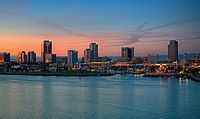
Photo from wikipedia
Background: Traffic and industrial emissions are associated with increased pediatric asthma morbidity. However, few studies have examined the influence of city industrial zoning on pediatric asthma outcomes among minoritized communities… Click to show full abstract
Background: Traffic and industrial emissions are associated with increased pediatric asthma morbidity. However, few studies have examined the influence of city industrial zoning on pediatric asthma outcomes among minoritized communities with limited access to air monitoring. Methods: In this cross-sectional analysis of 39,974 school-aged students in Santa Ana, CA, we investigated the effect of proximity to areas zoned for industrial use on pediatric asthma prevalence, physical fitness, school attendance, and standardized test scores. Results: The study population was 80.6% Hispanic, with 88.2% qualifying for free/reduced lunch. Compared to students living more than 1 km away from industrial zones, those living within 0.5 km had greater odds of having asthma (adjusted OR 1.21, 95% CI 1.09 to 1.34, p < 0.001). Among children with asthma, those living between 0.5–1.0 km had greater odds of being overweight or obese (aOR 1.47, 95% CI 1.00, 2.15, p = 0.047). Industrial zone proximity was not significantly associated with worse fitness and academic outcomes for students with asthma. Conclusion: These findings suggest that industrial zone proximity is associated with increased pediatric asthma in a predominantly Latino community in Southern California.
Journal Title: International Journal of Environmental Research and Public Health
Year Published: 2022
Link to full text (if available)
Share on Social Media: Sign Up to like & get
recommendations!